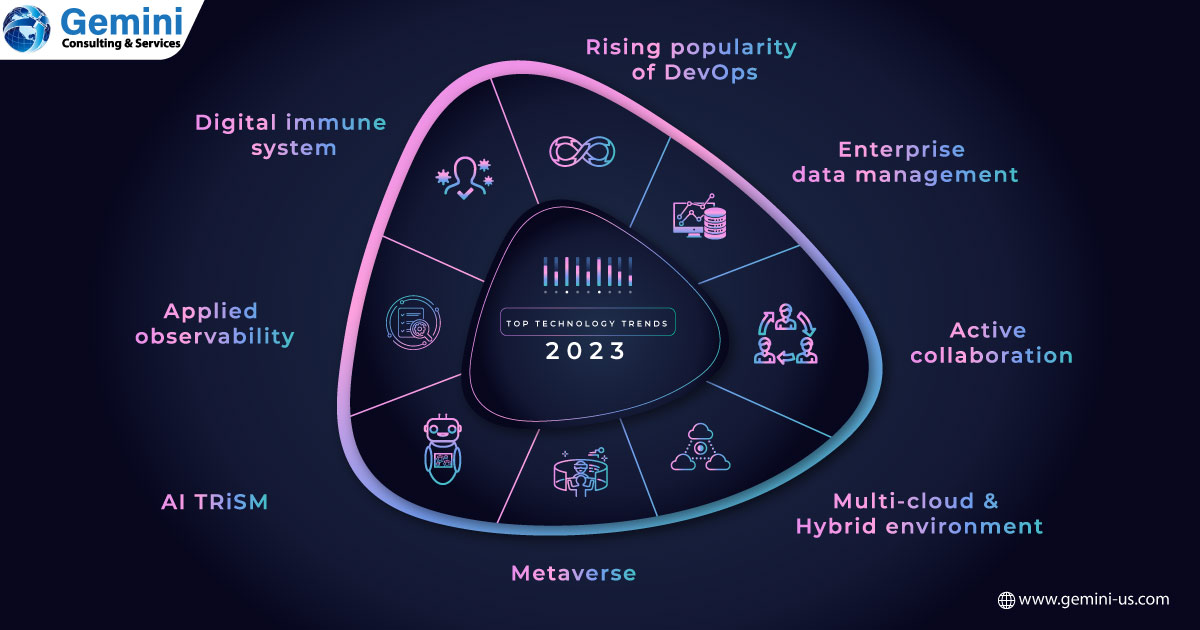Enterprises need to accelerate growth, reinvent business models and reduce costs to survive in a hypercompetitive marketplace. New technologies can help businesses achieve these goals. As a result, it is imperative for business leaders to understand new trends in technology and how they impact their business operations.
It is easier for an enterprise to choose and implement the right technology if it knows how it can affect its business.
According to Gartner, the top three strategic technology trends for 2023 are Digital Immune System, Applied Observability and AI Trust, Risk, and Security Management (AI TRiSM).

Let us understand these top trends and their impact on various businesses.
What Is a Digital Immune System and Why Is It on Top?
A digital immune system consolidates all practices and technologies of software design, development, automation, operations, and analytics to create a seamless end-user experience. This handles usual system failures that impact business performance while making the infrastructure more resilient. A digital immune system aims to improve user experience (UX) and bring down system failures that harm business performance. It combines a variety of practices and technologies from software design, development, automation, operations, and analytics to ensure business continuity and drive resilience.
Applied Observability
An average business generates scores of data across various operations with the potential to provide critical insights into performance. Applied observability refers to the set of intuitive tools and practices in IT and cloud computing that help correlate, aggregate, and analyze such data across distributed applications. Now it can effectively monitor, troubleshoot, and debug applications that help meet customer experience expectations, Service Level Agreements (SLAs), and other performance-oriented business requirements. Applied observability is a natural evolution of the application performance monitoring system that advances a dynamic process’s monitoring mechanism and automation.
What Is AI TRiSM?
Let us understand this with an example. Say you are headed to a new location within your city, and your first instinct as you set out is to look for Google Maps. You receive directions to the shortest route along with traffic updates on. Wondered how?
AI is a powerful, diverse tool used to solve countless digital queries that extend to areas of fraud analysis, trading securities and self-driving cars which is not too far away in the future. However, AI is already used to accepting or rejecting loan and job applications. While this development is powerful, the benefit such a tool depends on its successful implementation. Imagine losing millions in financial losses, immeasurable reputation, or goodwill loss if an effort to deploy AI fails.
AI TRiSM is a framework that supports AI model governance and ensures the trustworthiness, reliability, robustness, efficacy, and privacy of data. It encompasses all solutions, techniques, and processes that safeguard operational data and help resist the adversarial attack on customers and the business. With AI TRiSM, an enterprise can obtain better outcomes with AI adoption, and work in line with business goals and user acceptance in a risk-free and secure environment.
It is crucial for enterprises to expand their technological infrastructure based on these trends that can foster and propel business optimization. Gemini Consulting & Services can offer you strategic advice on how to ride these trends. Contact us to discuss more cutting-edge technologies that can be implemented for your business to improve growth.
The Impact of the Metaverse
According to McKinsey & Company, 79% of active consumers have purchased the metaverse so far, and over $120 Bn has been invested to power the metaverse marketplace in 2022.
The metaverse is all set to deliver a new dimension to businesses to help them engage in marketing with their audiences. 3D and virtual shopping experiences have already made an entry and are slated to become far more immersive in both the digital and physical realms. Digital spaces have the potential to break or create a brand. The year 2023 will be remembered as when a business will need to begin preparing to embrace this development.
Active Collaboration
Hybrid work cultures with flexible work schedules have almost become the norm with multiple businesses. Therefore, the need for adjusted platforms with new features that help make collaboration easy and seamless is already in demand. Process and data silos are collapsing, with brands like Microsoft, Oracle, AWS, and SAP leading the pack in integrating applications and productivity tools. AI, Metaverse, and 5G connectivity will further enhance digital and physical collaboration.

Multi-Cloud and Hybrid Environments
2022 saw a lot of businesses opting for hybrid clouds. There is a definite shift expected from this to multi-cloud in 2023. Organizations are slated to optimize cloud usage by tapping into offerings from leading cloud service providers like AWS, Google, and Microsoft Azure. Public cloud players have also made their offerings extensible over the last few years, ensuring that businesses obtain the desired flexibility. Adopting a multi-cloud environment will help companies to do away with redundancy, scalability, compliance and other challenges.
Adopting Enterprise Data Management (EDM)
Enterprise data is the consolidated digital information flowing across applications within an organization. This includes structured and unstructured data, such as records in spreadsheets and relational databases, and those such as images and video content. Now EDM is an architecture that provides consistent data service capabilities connecting endpoints across multi-cloud environments. It standardizes processes for handling data in the cloud, on-premise, and computing devices. It ensures that data is accessible from anywhere. In the next few years, it is expected that the adoption of enterprise data management will see a surge.
The Rising Popularity of DevOps
Global Market Insights has predicted the DevOps Market to grow over 20% CAGR from 2020 to 2026. The size of the DevOps market was over $4 billion in 2019.
DevOps has long established itself as a critical development methodology for software developers. It aids in quicker software delivery, higher quality, and customer satisfaction, pushing enterprises across sizes and domains to embrace it actively. DevOps will continue to evolve, disrupt and help drive considerable digital transformation that aligns application development with organizational goals.



